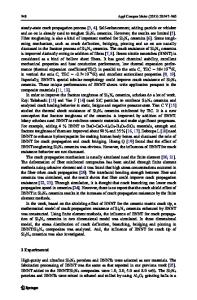Topographic/structure changes of implanted Si 3 N 4
- PDF / 1,633,351 Bytes
- 6 Pages / 576 x 792 pts Page_size
- 40 Downloads / 314 Views
A series of investigations were carried out to evaluate the topographic and structural effects of ion implantation on monolithic Si3N4 ceramic surfaces. Implantations were performed with N 2 , Ne, or Ar in the fluence range of 2.0 X 1016 to 4 X 1017 particles/cm 2 and implant voltages of 125 to 200 keV, depending on the mass of the implanted species. Single crystal Si and SiC were also examined for comparative purposes. Noble gases produced blisters on Si3N4 and significant increases in surface expansion. TEM examination of the Si 3 N 4 blister shell showed a distribution of small bubbles, ranging in size from 5 to 300 nm, depending upon the type of Si 3 N 4 , and a transformation of the original crystalline structure into an amorphous phase. Analysis of the blister shell, using electron energy loss spectrometry (EELS) and energy dispersive x-ray spectrometry (EDXS) showed that a significant quantity of the implanted Ar was still present in the blister (skin).
I. INTRODUCTION The use of ion implantation has now advanced far beyond its initial application to semiconductor processing. It is now extensively used to modify a broad range of materials in order to produce specific changes in chemical or mechanical properties. For example, improvements in the surface properties of ion-implanted metals and metal alloys include corrosion and wear applications.1 Ceramic and ceramic composites offer significant technological advantages over their metal counterparts in high temperature oxidizing environments and any surface property improvements will greatly facilitate their commercial exploitation. The implantation of ceramics could be a fruitful area of research. The modification of ceramic surfaces, however, is fundamentally more complex and has produced mixed results that depend very strongly upon the sample and the type and fluence of the implanted ions.2"5 At higher fluences, these modifications generally include structural damage, which leads to reduced crystallinity or amorphous transformation of the implanted zone6; an expanded surface resulting in a less dense surface layer; reduced indentation hardness; and internal bubbles leading to reduced mechanical strength and, in more extreme cases, blister formation. The formation of bubbles and blisters in metals has been known for over 30 years. They were observed in metals after exposure to the high radiation levels in nuclear reactors,7 as well as in certain corrosive and hydrogen environments at high temperatures.8 Recent studies have also reported the presence of bubbles and
^Present address: Boston University, College of Engineering, 44 Cummington Street, Boston, Massachusetts 02215. J. Mater. Res., Vol. 7, No. 9, Sep 1992
http://journals.cambridge.org
Downloaded: 18 Mar 2015
surface deformation in noble gas implanted amorphous alloys.9 Surface deformation of ceramics after exposure to high dose implantation has been observed for a wide range of ceramic materials and glasses. For example, bromine implanted into single crystal A12O3 resulted in a thin amorphous lay
Data Loading...











